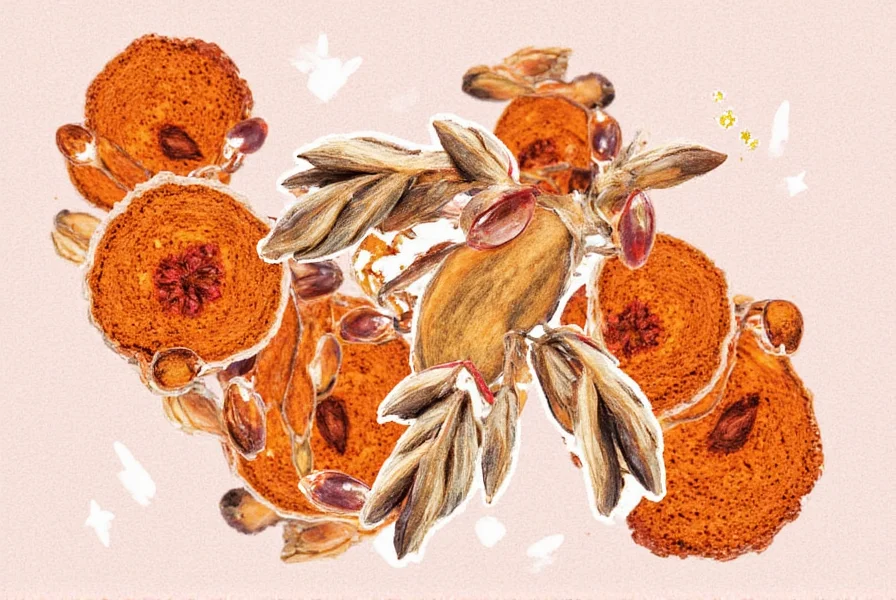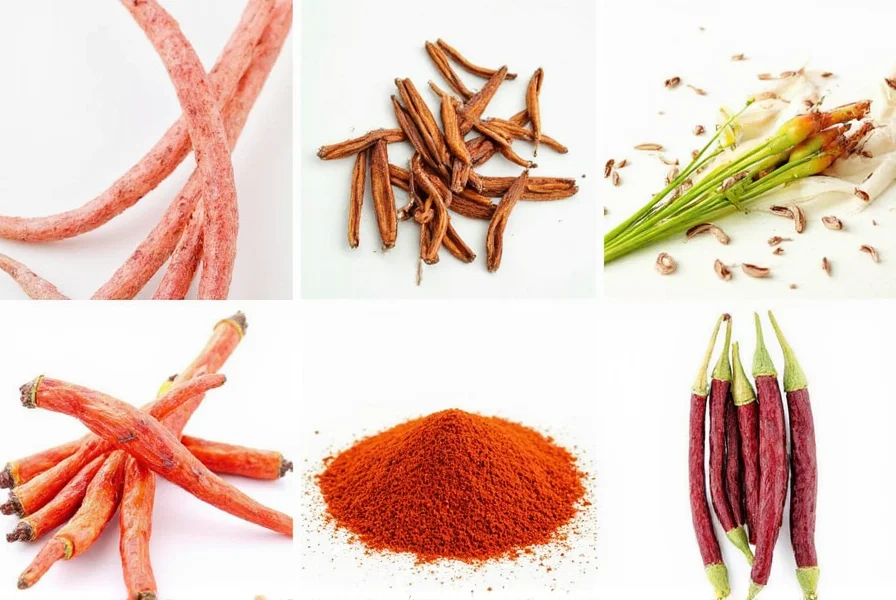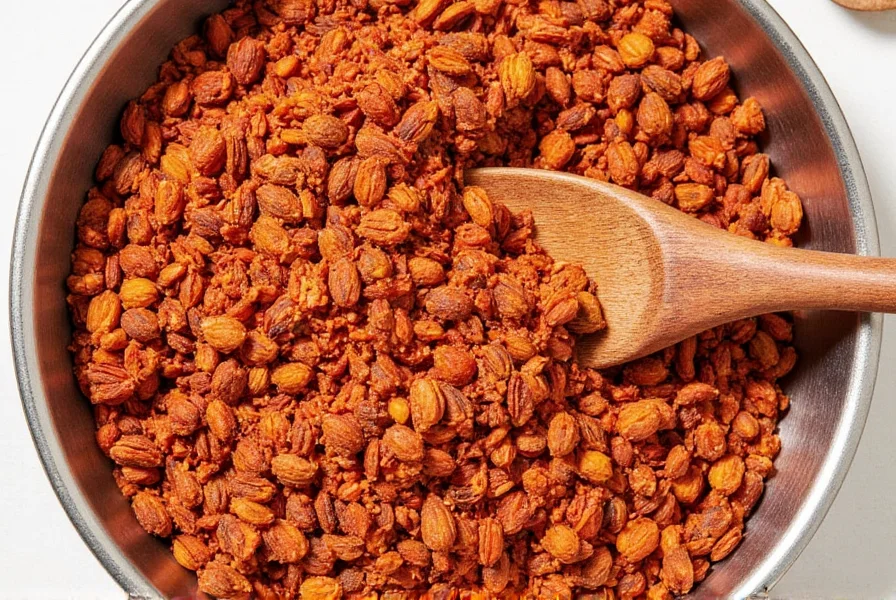Looking for Chinese five spice alternatives? Here are 5 easy-to-find substitutes that will keep your dishes flavorful. Whether you're out of the spice blend or just want to try something new, these options work great in stir-fries, marinades, and more.
| Substitute | Heat Level | Sweetness Level | Best Use |
|---|---|---|---|
| Four Spice Blend | Moderate | High | Traditional meat dishes |
| Garam Masala | Mild to moderate | Moderate | Curries, roasts |
| Patent Express Blend | Varies by brand | Varies by brand | Convenience cooking |
| Allspice | Mild | High | Slow-cooked meals |
| Hoisin + Sesame Oil | Mild | Moderate | Sauces and marinades |
1. Four Spice Blend
The name says it all: this blend skips the Sichuan pepper but keeps the essence of sweetness and warmth. Usually composed of star anise, cloves, cinnamon, and fennel, it's ideal for those who want the flavor without the numbing kick.
| Spice | Flavor Profile | Use Case |
|---|---|---|
| Star Anise | Sweet, licorice-like | Meat marinades, braised dishes |
| Cloves | Earthy, sharp | Pickling, holiday baking |
| Cinnamon | Warm, sweet | Rubs, desserts |
| Fennel Seeds | Herbaceous, mild licorice | Vegetable dishes, sausage blends |
2. Garam Masala
If you're looking for warmth with a bit more complexity, garam masala might be your new best friend. This Indian spice blend typically includes cardamom, cumin, coriander, black pepper, cloves, and cinnamon.

It's earthier than Chinese five spice but still brings a bold aromatic profile that works great in roasted meats and vegetable curries.
3. Patent Express Blends
These are pre-mixed spice blends designed to mimic the flavor of Chinese five spice. Brands like McCormick and Badia offer versions labeled as "five spice alternatives" or "Asian seasoning." They often combine similar spices with added herbs for convenience.
| Brand | Key Ingredients | Best For |
|---|---|---|
| McCormick Asian Seasoning | Garlic, ginger, red pepper flakes, sesame | Quick stir-fries and noodle dishes |
| Badia Five Spice Mix | Anise, cinnamon, clove, fennel, pepper | Traditional Chinese recipes |
4. Allspice or Cinnamon
If you're short on time or ingredients, reach for allspice or cinnamon alone. While not a direct substitute, they bring that sweet, warm flavor that's key to the Chinese five spice experience.
- Allspice: Similar to clove and cinnamon together. Great for stews and roasts.
- Cinnamon: Adds warmth and sweetness. Ideal for desserts or glazes.
5. Hoisin and Sesame Combo
Technically not a spice, but a flavor duo worth mentioning. Mixing hoisin sauce with toasted sesame oil can replicate the richness and depth of Chinese five spice in sauces and marinades.

Try it in:
- Glazed chicken
- Stir-fried noodles
- Dipping sauces
How to Choose the Right Substitute
Not all substitutes are created equal. Depending on your recipe and desired outcome, you may need to choose wisely. Here's a handy guide:
| Substitute | Heat Level | Sweetness Level | Best Use |
|---|---|---|---|
| Four Spice Blend | Moderate | High | Traditional meat dishes |
| Garam Masala | Mild to moderate | Moderate | Curries, roasts |
| Patent Express Blend | Varies by brand | Varies by brand | Convenience cooking |
| Allspice | Mild | High | Slow-cooked meals |
| Hoisin + Sesame Oil | Mild | Moderate | Sauces and marinades |
Buying Guide for Alternative Spices
If you're planning to stock up on these alternatives, here's a quick breakdown of what to look for in each type of spice blend or single ingredient:
Four Spice Blend – Buyer's Notes
- Features: Sweet-forward, minimal heat
- Advantages: Balanced flavor, easy to use
- Target Audience: Home cooks, traditionalists
- Best Brand: Frontier Co-op Organic Four Spice
Garam Masala – Buyer's Notes
- Features: Complex, warm, slightly spicy
- Advantages: Versatile across cuisines
- Target Audience: Adventurous cooks
- Best Brand: Everest Garam Masala
Patent Express Blends – Buyer's Notes
- Features: Pre-mixed for ease
- Advantages: Saves prep time
- Target Audience: Busy cooks, beginners
- Best Brand: McCormick Asian Seasoning Mix
Allspice – Buyer's Notes
- Features: Rich, warming flavor
- Advantages: Single spice simplicity
- Target Audience: Minimalist chefs
- Best Form: Whole berries (for grinding)
Sesame Oil – Buyer's Notes
- Features: Nutty, aromatic
- Advantages: Enhances umami and depth
- Target Audience: Stir-fry lovers, marinade-makers
- Best Brand: Kikkoman Toasted Sesame Oil
Frequently Asked Questions
What exactly is in Chinese five spice?
Traditional Chinese five spice is a blend of five key ingredients: star anise, cloves, Chinese cinnamon (cassia), Sichuan pepper, and fennel seeds. This combination creates a balance of the five fundamental flavors in Chinese cuisine: sweet, sour, bitter, salty, and umami.
Can I make my own Chinese five spice blend at home?
Absolutely! Making your own is simple. Combine 2 tablespoons of toasted Sichuan peppercorns, 2 tablespoons of fennel seeds, 2 cinnamon sticks (broken), 1 tablespoon of whole cloves, and 1 star anise. Grind to a powder using a spice grinder or mortar and pestle. Store in an airtight container for up to 6 months.
How is Chinese five spice different from garam masala?
While both are warm spice blends, they come from different culinary traditions. Chinese five spice features star anise and Sichuan pepper prominently with a balance of sweet and numbing flavors. Garam masala is Indian in origin and typically includes cardamom, cumin, coriander, and black pepper, creating a more earthy, complex profile without the distinctive anise or numbing notes.
Which substitute works best for roast duck or pork?
For traditional Chinese roast meats like duck or pork, the four spice blend is your best alternative as it maintains the core flavors without the numbing quality of Sichuan pepper. If you prefer some heat, the Patent Express Blends (like Badia Five Spice Mix) would be the next best option for authentic results.
Can I use pumpkin pie spice as a substitute for Chinese five spice?
Pumpkin pie spice shares some components (cinnamon, cloves, allspice) but lacks star anise and Sichuan pepper. It can work in a pinch for sweet applications or glazes, but won't provide the authentic Chinese flavor profile. For savory dishes, it's not the best substitute due to its sweeter, more dessert-oriented profile.
How should I store these spice alternatives to keep them fresh?
Store all spice blends in airtight containers away from heat, light, and moisture. Whole spices last longer (up to 2 years) than ground spices (6 months to 1 year). For best flavor, buy small quantities and replace regularly. Freezing can extend the life of spice blends if you won't use them quickly.
Are there any health benefits to these spices?
Many spices in these blends offer potential health benefits. Cinnamon may help regulate blood sugar, cloves contain eugenol which has anti-inflammatory properties, star anise is rich in antioxidants, and Sichuan pepper may aid digestion. However, these benefits are best realized when spices are part of a balanced diet, not consumed in excessive amounts.
Final Thoughts: Spice It Up!
Who knew swapping out Chinese five spice could open up such a flavorful world? From four-spice blends to garam masala and even hoisin-based combos, there's no shortage of delicious options to keep your meals interesting.

Next time you're out of your go-to blend, don't panic — just grab one of these alternatives and turn your dish into a masterpiece. Happy cooking, and may your kitchen always smell amazing!












 浙公网安备
33010002000092号
浙公网安备
33010002000092号 浙B2-20120091-4
浙B2-20120091-4